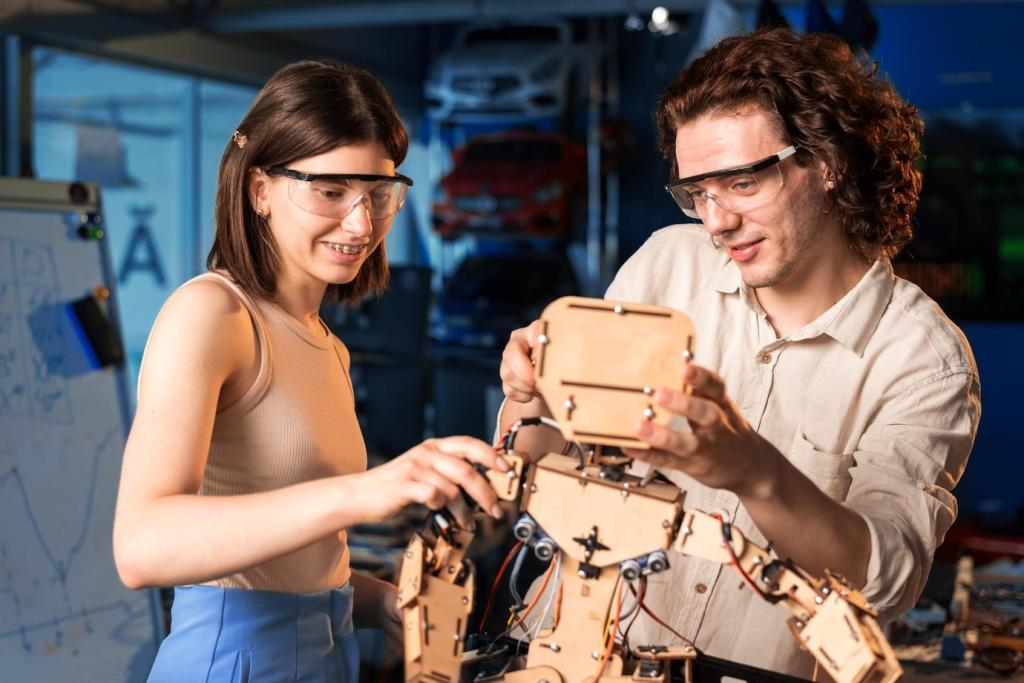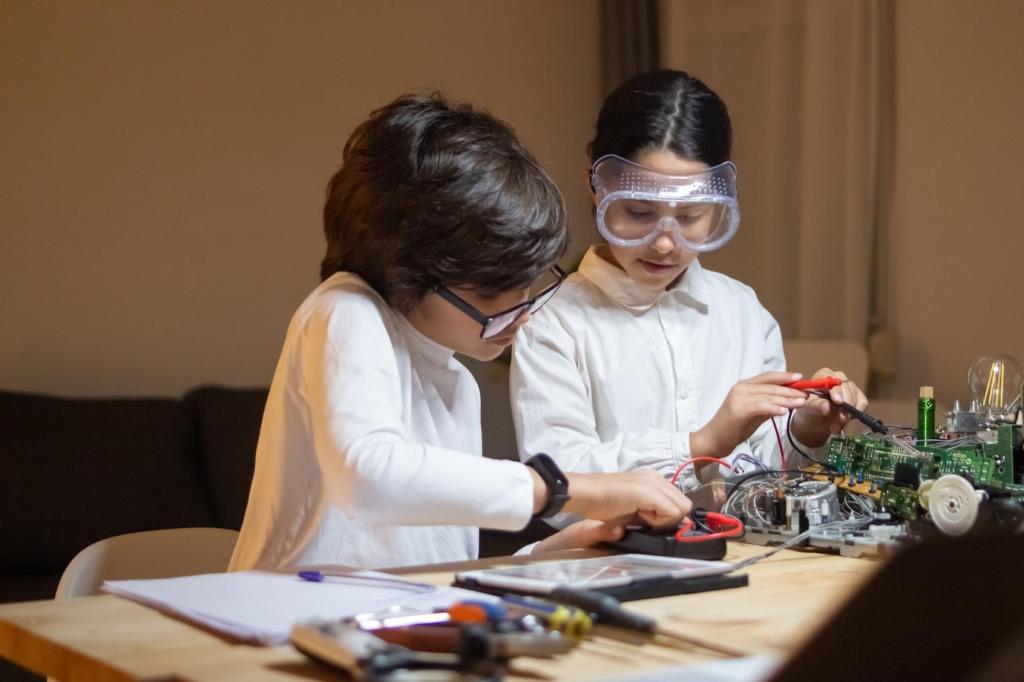
Beginner-Friendly Robot Projects for Kids: Build, Play, and Learn
Chosen theme: Beginner-Friendly Robot Projects for Kids. Welcome, curious makers and supportive grown-ups! Today we kick off a playful journey into robotics where imagination leads, safety guides, and every tiny victory sparks a lifetime love for building.

The Essentials: Simple, Safe Materials
Begin with easy, low-cost items: AA batteries, a coin cell, mini vibration motors, popsicle sticks, toothbrush heads, tape, markers, rubber bands, and googly eyes. Add scissors, a child-safe screwdriver, and a small storage box. Keep everything labeled and reachable, so kids can help themselves and feel proud managing their own toolkit.

Safety Habits That Build Confidence
Model safe routines from the start: discuss battery polarity, keep liquids away from electronics, and supervise any hot glue or sharp edges. Establish a tidy workspace zone, a clean-up bell, and a “hands off, eyes on” check before powering anything. Consistent, calm reminders reduce stress, prevent mistakes, and encourage thoughtful, patient making.

Prep Party Checklist
Make preparation fun. Turn gathering supplies into a scavenger hunt where kids find motors, tapes, and stickers. Use a big, friendly checklist with drawings and checkboxes. When kids help prep, they remember where things live, practice responsibility, and feel ownership over their beginner-friendly robot projects from the first happy beep to the final dance.
First Build: The Joyful Bristlebot
Why Bristlebots Spark Curiosity
Bristlebots are quick wins. Children see a direct link between power, vibration, and movement within minutes. They experiment with balance by shifting the battery or motor, notice friction differences on carpet versus tile, and discover creative decorations influence motion. The immediate feedback loop invites tinkering and cheerful, beginner-friendly problem solving.
Step-by-Step Success, No Tears
Stick a coin cell to the toothbrush head, attach the vibrating motor leads, secure everything with tape, and decorate with markers or feathers. Test on a smooth surface, then adjust weight placement to improve stability. Celebrate small improvements aloud. Invite kids to name their bots. Share photos in the comments, and subscribe for more playful builds.
A Kitchen Racetrack Anecdote
One Saturday, Jamal built two bristlebots and taped a masking-tape racetrack around the kitchen island. He learned quickly that moving the motor slightly changed speed and direction. His sister judged “best costume” using glittery fins. Their proud, unexpected lesson: tiny adjustments, plus a timer and cheers, turn first robots into joyful family science.
Plan Before You Build: Unplugged Coding Games
Create arrow cards for forward, left, right, and pause. Place them in a sequence to guide a pretend robot across taped floor tiles. Kids read each step aloud, then walk the path. This simple routine builds clear thinking, encourages patience, and connects naturally to later programming for beginner-friendly robot projects.
When the pretend robot bumps into a chair, place a sticky note where the mistake happened and discuss which step misled the robot. Replace just that card rather than starting over. Kids experience debugging as gentle, focused improvement, not failure. This mindset makes robotics feel welcoming and repeatable, perfect for brand-new builders.
Ask kids to invent silly commands like “spin like a comet” or “tiptoe past lava tiles,” then map them to simple moves. Post your favorite sequences in the comments so other families can try them. Subscribe for weekly beginner-friendly challenges that transform living rooms into playful, low-stress labs of imagination and logic.
Sensors Made Simple: Light and Touch
Flashlight Chaser Exploration
With a kid-friendly kit or microcontroller board prepared by an adult, show how covering a light sensor slows a motor and shining a flashlight speeds it up. Let children experiment with shading the sensor using fingers or paper flaps. They learn cause and effect while staying focused on safe, beginner-friendly robot projects.
Bumper Switch Adventures
Make a soft cardboard bumper that presses a simple switch when the robot meets a wall. On contact, the bot changes direction or pauses. Children love listening for the tiny click and predicting outcomes. This tactile feedback builds intuition about inputs and outputs without overwhelming first-time makers with complicated circuitry or confusing diagrams.
Games That Teach Observation
Create a “sensor safari” where kids record what happens when the room is darker, brighter, louder, or quieter. Encourage hypotheses before each trial, then compare results. Invite readers to comment with their funniest sensor surprises. Reliable observation habits support lifelong tinkering, making every beginner-friendly robot project feel like a miniature scientific expedition.

Decorate robots with paper capes, pipe-cleaner antennae, and cardboard fins, then test how decorations change balance or speed. Kids experience engineering trade-offs with smiles. Ask them to sketch their ideas first, like real designers. Share your most imaginative looks, and subscribe for monthly themed challenges celebrating artistic, beginner-friendly robot projects for kids.

Give each robot a mission: deliver a paper “message,” rescue a pom-pom from a maze, or cross a sticky note canyon. Storylines transform practice into purpose, encouraging focused repetition. Children naturally iterate costumes and components to complete missions, discovering how small tweaks lead to big wins without feeling like homework or chores.

Host a living-room parade with a starting line, music, and cheering. Kids announce their robot’s name, costume features, and special moves. Snap photos and share highlights in the comments so our community can applaud. Public celebration builds pride, reinforces learning, and keeps beginner-friendly robot projects exciting week after week.
Teamwork That Teaches: Roles and Routines
Rotate roles to keep everyone engaged. The Builder assembles parts, the Tester observes and records behavior, and the Designer sketches improvements. Each role matters, and rotation prevents arguments. Kids experience engineering as a friendly team sport, which strengthens patience, listening, and problem-solving across every beginner-friendly robot project they attempt together.


Teamwork That Teaches: Roles and Routines
Adults can ask guiding questions instead of giving commands: “What changed when we moved the battery?” or “How could we slow the spin?” This approach lets children own victories and learn from mistakes. Your voice becomes a calm compass, not a steering wheel, making robotics inviting for anxious beginners and energetic explorers alike.
Troubleshooting With Heart: Tiny Triumphs Matter
If the bot won’t move, check battery orientation, secure motor leads, lighten decorations, or try a smoother surface. If it wobbles wildly, adjust the weight or shorten the bristle base. Keep a friendly checklist handy. Remind kids that real engineers test, tweak, and smile when persistence leads to a delightful wiggle.
Set a thirty-second quiet-watch moment before changing anything. Kids notice patterns in turns, stalls, and surface friction. Invite them to draw what they observed and predict one change to try next. Post your child’s observation sketch, and subscribe to receive printable logs that turn tinkering into memorable, beginner-friendly science.
Create a cheer for each improvement: “We moved the battery and it straightened out!” Record tiny triumphs on a progress poster. This transforms setbacks into stepping stones. Share your family’s favorite cheer in the comments, and join our newsletter for more compassionate coaching tips and kid-tested robot project ideas.

